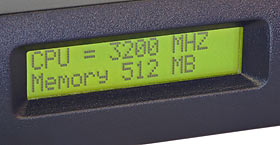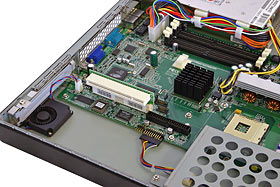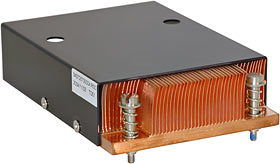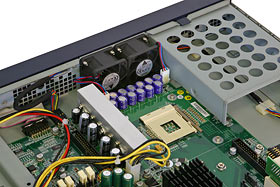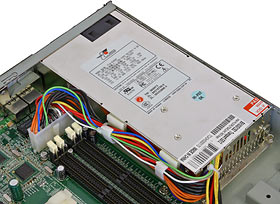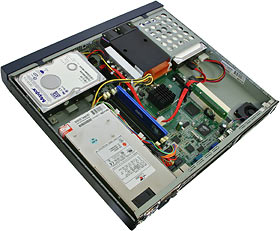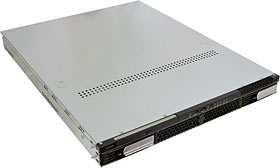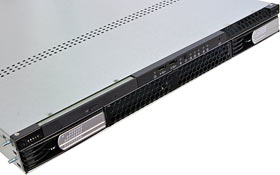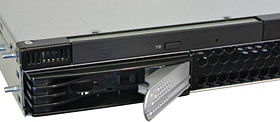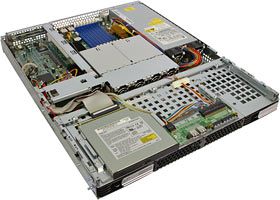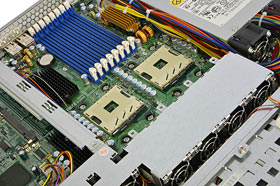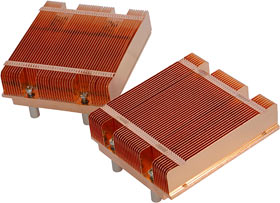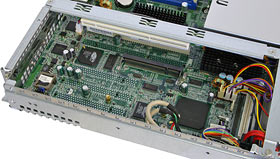
Tyan Transport GS12 and GX21 1U rackmount servers
Review date: 28 April 2005. Last modified 03-Dec-2011.
If you want to pack a bunch of full-featured basic x86 servers - with at least one big hard drive each, nothing much shared, and at least a current-issue desktop processor, not some low-power basic chip - into a small space, your only option is rack mounting.
People who only need a few servers can make do with standard tower or desktop enclosures. But you can fit a proper server-class PC into a "one unit" (1U) rack enclosure, and by definition that means you can have a whole server that takes up only 1.75 inches of vertical space. Forty machines will fit in a rack that's shorter (though not necessarily lighter...) than the average human male, and it's no big thing for them each to have two hard drives and two CPUs, if that's what you need.
So that's all very well, but the tricky bit is doing it all for a reasonable price. Like things sold for medical purposes, and things sold in camera shops, and things sold to people who've already demonstrated such bad financial judgement as to have purchased a radio controlled helicopter, things with "Server" written on the box generally feature a surprisingly large mark-up, given their basic specifications.
There's nothing magic about this kind of server hardware; if you're talking four or more CPUs and/or non-x86 architecture then there's a considerable real baseline price increase, but any old PC can do many server tasks. And a PC built with better-than-average components - good PSU, motherboard that you didn't buy at an open air market, maybe a 10,000RPM drive - should be just as durable as a purpose-built x86 server.
Once you start talking rackmount, though, you also start talking excitingly pumped-up prices. Maybe you're paying for a serious support contract, but disturbingly often, you're not (or the contract you do pay for turns out not to be worth what you pay...).
Server makers also have an annoying tendency to assume you want a "server class" CPU. Now, if you want multiple processors in an x86 server, then you definitely do want a Xeon or Opteron box. But a lot of people buying up-to-two-processor Xeon and Opteron machines with only one chip in them will never add another processor - or will, by the time they do need more speed, be able to buy another single-chip box that's faster than upgrading their current machine.
Buying a one-chipped two-way box is not a totally crazy idea on its face, given that basic 533MHz and 800MHz-bus Xeons are going for only around four hundred Australian dollars now, for the 2.8GHz versions at least.
In the meantime, though, the substantial premium you pay for a brand name server with one chip may well do your business more harm than the machine's upgradability will heal.
So let's say you're looking for a plain old single-Pentium-4 1U server, or perhaps a dual Xeon box. With two chips. At a reasonable price. What should you buy?
Well, perhaps one of these.
Option A
This is Tyan's Transport GS12 (model B5103). It's a 1U Socket 478 machine with all of the features you'd expect, these days - except the price.
The GS12 looks almost as dull as every other suit-and-tie rackmount server. No funky colours, no array of blinkenlights. But you do get a yellow power button. And a two-line LCD display.
The display doesn't just give you basic status info, like this; it's a programmable device, permanently connected to a COM port as far as the GS12 mainboard's concerned. The GS12 comes with driver software for the display for Win2000, XP and 2003, Red Hat, SuSE and Turbo Linux, and FreeBSD; you can use it to display whatever you like. System load, error messages, Winamp playlist...
Actually, if you're not doing anything else with the display, tying it into some kind of media player could work pretty nicely, seeing as the display's flanked by four-way cursor buttons, plus a Select and a Cancel button. All controllable via the driver, of course, provided you have something resembling coding ability.
Apart from the display, the only points of interest on the front panel are two USB ports, ideal for impromptu keyboard and mouse connection.
(They're USB 2.0 ports, of course, so you can plug storage devices in
there as well and not have to wait an age for your CD to finish
ripping important OS patches to install.)
The Transport line comes with a couple of other server utilities, for the same collection of popular server OSes. There's a watchdog driver so you can auto-reset the system if it hangs, and an ASF (Alert Standard Format) utility to allow the server to send an SNMP trap if its hardware monitor notices a slow fan or high temperature.
On the back of the GS12, you get one covered expansion slot, two USB connectors (one oddly placed below the expansion slot), VGA and serial ports, and the two RJ45 network sockets (both gigabit Ethernet capable, of course; they run from Intel 82541GI and 82547GI controllers).
And, of course, quite a few holes; rackmount hardware's ventilated from front to back, and so needs to be pretty much made out of chicken wire at both ends.
The GS12 has no PS/2 mouse or keyboard connectors, so if you've got your servers plugged into an old KVM (Keyboard, Video, Mouse) switch, you won't be able to control it without giving it its own USB input devices. Plenty of cheap KVMs support USB these days, though.
Remove a few screws and the lid lifts off...
...revealing this.
This isn't an especially featureful server, so its innards don't look a whole lot different from a normal PC motherboard. CPU socket, Northbridge heat sink, four RAM slots (the GS12 is perfectly happy with up to 4Gb of regular DDR266, 333 or 400 memory; you don't have to use fancy ECC modules if you don't want to), parallel and serial ATA drive connectors...
...and one PCI slot, with a riser card to turn the slot around, and a dinky little exhaust fan to stop hot SCSI cards from burning up.
The PCI slot's only meant to accept a normal "short" card (less than 7 inches, according to the manual), but you could probably shoehorn a longer card in there by removing the drive cage in front of the slot, and doing a bit of wedging work.
Since it's only a standard 32 bit 33MHz slot, though, you can't use most server cards in it anyway.
The GS12 has two drive bays, and supports pseudo-hardware RAID 0 and 1 under Windows (via the universally adored Intel Application Accelerator), if you use SATA drives. RAID 1 - mirroring - makes sense for many servers.
If you're just interested in bulk storage, of course, two drive bays these days also means an easy 465 formatted gigabytes of cheap un-RAIDed ATA storage; around 560 gigabytes if you spring for more-expensive-per-megabyte 300Gb drives. And nominal "400Gb" drives (real formatted capacity more like 370Gb) are out, now; they cost about 1.6 times as much per gigabyte as 250Gb units, though.
The GS12, like any rackmount server worth its salt, comes with a selection of cables of the exact right length to fit in the case. The ribbon cables are neatly pre-origami-ed, for your convenience.
When you're building a rackmount box, you
Note that the drive here isn't plugged in to a PSU lead - it's drawing power from a custom cable that plugs into the motherboard, to save you snaking another wire right across the server.
The GS12 runs the not-too-new i875p chipset, so it wants a Socket 478 processor.
Socket 478 ain't glamorous, and it's no longer cheaper than LGA775, but it certainly still offers you a broad range of chips - from Prescott-based Celeron Ds costing around $AU150 delivered (or the older Northwood Celerons, but the Prescott ones are only a little more expensive and much faster clock for clock) to the silly Extreme Edition 3.2 and 3.4GHz chips, which are basically Xeons without multiprocessing support.
Or, if you're vaguely sensible, you can buy the only-barely-slower 3-to-3.4GHz regular P4s. A 3GHz chip's under $AU300 delivered, these days, and is more than adequate for server tasks that used to be the domain of horrendously expensive multiprocessor boxes.
Ordinary CPU coolers don't fit in a 1U case, of course, so the GS12 comes with this tasty slab of copper.
It's cooled by two ferocious 40mm fans at the front of the casing, which spin up to full power when you turn the server on, and may frighten small children.
The fans are thermally controlled, though, so a GS12 without much CPU load shouldn't make much more of a racket than a regular desktop PC.
The GS12 runs from a small, but surprisingly grunty, power supply. 300 watt max rating, 284 watts from the 5, 3.3 and 12V rails between them, world-compatible for voltage and frequency. 300 watts will be OK even if you install a couple of screaming SCSI drives; it'd be borderline for a stacked desktop system, but 1U servers don't have 50 watt video cards.
The GS12 also, of course, comes with rack rails and fasteners and covers and so on.
The finished item.
So that's all hunky-dory. The big question is, of course, what the thing costs.
Well, bare, with no CPU or drives or RAM, it's $AU869 including Sydney metropolitan delivery, from Aus PC Market (customers outside Sydney will pay more).
More relevantly, they'll pre-stack it with a 3GHz P4, 1Gb RAM (in two modules, leaving two slots free) and two 160Gb SATA drives, for $AU1672, including the same delivery deal. You can tweak this configuration as you like, of course.
Hold that thought. On to the bigger brother.
Option B
This is the Transport GX21 (model B5350).
It's a couple of rungs further up the server specification ladder from the GS12; you get two mPGA604 Xeon sockets, one 64 bit 66MHz PCI-X slot, and a pair of hot-swap SATA drive bays.
MPGA604 sockets can accept 603 or 604-pin Xeons; the extra pin is just keying to stop 604-pin chips, which want 533 or 800MHz bus speed, from being used on an old 400MHz 603-pin motherboard.
Oh, and note that hardware hot-swap is not the same as software hot-swap. Run plain old Windows on this box and yank its boot drive and you'll probably not make the OS happy at all.
The GX21 also has a built-in slim CD-ROM drive - hardly essential, but convenient. There's a space for an optional slim floppy drive, too.
There's no LCD display on the GX21's front panel, but you do get that CD-ROM drive, and the two lever-action drive bays, and two USB ports.
The bay locks are easy to operate. This setup lets you swap in new drives if you buy extra bay-trays, of course, but its primary advantage is that it lets you quickly replace a dead drive without yanking the whole server out of the rack. Or you can pop one or both drives and lock them away, if you like.
The back panel's only slightly more elaborate than the GS12's. One expansion slot, two gigabit-capable Ethernet connectors, VGA out, one serial port, a couple more USB ports (you don't get FireWire), and good old PS/2 mouse and keyboard connectors.
(By the way - both of these servers, and an amazing number of others out there, offer the incredible 3D power of the 8Mb Rage XL graphics chip. The Rage XL was a "value" chip in 1999. It's perfectly fine for 2D.)
The GX21 lid comes off easily too...
...to reveal a fancier interior than the GS12 can offer.
The GX21 has a magnificent eight ram slots, into which you can install up to six DDR333 modules or up to eight DDR266 ones. It requires registered DDR memory (more expensive than regular DDR, but not nearly as ludicrously so as it used to be), but you can install up to 16Gb if your wallet can stand it.
Two CPUs means two heat sinks, which Tyan once again provide. Current high-end Xeons have a Thermal Design Power (which isn't even the worst case scenario heat output - it's just what you can expect them to do on average when they're working hard) of more than a hundred watts, so keeping them cool in a 1U rack case is not easy.
Hence: A phalanx of those finger-chewing 40mm fans (the four CPU cooling fans top out at 15,500RPM; the fans for the PSU and PCI slot are mere 15,000RPM units), which draw air through the clear portion of the casing between the drive bays, and shove it through the heat sinks, which have aluminium air-guide shrouds over them when you've finished installing everything.
(The CPU heat sinks foul the forward memory slot retaining levers, though, which could be a pain for upgraders.)
The fans are, again, thermally controlled - but there aren't any low-heat CPU options for a dual Xeon box, and if the processors aren't working hard most of the time then you probably didn't need 'em in the first place, so your bedside table is unlikely to be the ideal installation location for this machine.
The GX21 power supply, by the way, has a five hundred watt rating, which looks pretty plausible based on the combined rail figures.
Yes, next to the riser-carded PCI slot, those are solder pads on the motherboard for extra PCI slots that aren't quite there. The Tiger i7510 motherboard in the GX21 is adapted from the i7320 desktop board, by the time-honoured strategy of not soldering on the parts that won't work in a 1U case.
The little card connector parallel to the PCI slot looks to me like an IPMI card socket, but it's not documented, so I presume it worketh not.
The PCI slot, though, most definitely can accept full-length cards; it's got a special retaining clamp to keep them in line.
The envelope, please
The bare-bones version of the GX21 sells for $AU1320, including Sydney metro delivery.
Again, you can order a GX21 with any combination of parts you like, but AusPC have a standard combo deal as well. You can get a GX21 with a pair of 3GHz 1Mb L2 cache Xeons, two 36Gb 10,000RPM Western Digital Raptor SATA hard drives, one 1Gb registered PC2700 (DDR266) RAM module, for $AU2967.80 including Sydney delivery.
Now, you might want more storage or memory or slightly cheaper 2.8GHz Xeons or something, but this is still a good baseline setup for price comparison purposes, and it compares very well indeed with the big-brand gear that corporate IT dealers would rather you buy.
It's hard to find servers like the GS12 at those dealers in the first place (they want to sell you a Xeon box with one chip, not a cheaper P4 that's just as fast), but you can usually get them to blow the dust off one if you insist.
If you do, you'll probably be looking at something like an IBM x306.
An x306 with a 3GHz P4, 512Mb of RAM, and (cough) no hard drive will set you back an easy $AU1700 ex delivery. So, more than the AusPC GS12 combo, but without any, you know, storage.
The baseline corporate-shop rackmount servers have been Xeon machines ever since ordinary Pentiums stopped being usable in pairs, and for a something around the specs of the GX21 you're talking, oh, maybe an HP ProLiant DL360G4.
For a SATA-drive DL360G4 with one lousy 3GHz 1Mb-cache Xeon, 1Gb of RAM and no hard drives, you're talking well over $AU3200. Four grand, easily, with two processors and something to boot off.
Or around a thousand bucks less, for the Tyan alternative.
There's an IBM contender in the basic two-way 1U Xeon market, too.
X346, one CPU, 1Gb RAM, no drive, four grand Australian, oh please.
(Yes, I know you can get these servers in the States for lower prices. You can probably get the Tyans cheaper too, but the gap isn't likely to be as big.)
There are other less-well-known-brand servers out there (I wouldn't say off-brand about Tyan; they're well known, they've been around for ages, and they've made solid gear for... well, for most of that time).
Supermicro, for instance, definitely have some strong 1U contenders, using every current Intel chip (Opteron lovers are left out in the cold). Their 5014C-MT sells for $US700 or less for the BYO-CPU-RAM-and-drive bare bones unit, takes an LGA775 Intel chip, and offers a PCI-X slot and four hot-swap SATA drive bays. And a CD-ROM drive, and an IPMI slot that actually works.
I don't know where to find it here in Australia, though; there are a few Supermicro 1Us on sale locally, but even the ones with sub-GS12 specs are generally a few hundred bucks more expensive.
Just to make things more confusing, of course, there's The Future. We stand on the cusp of wide availability of dual-core server chips, giving you something that broadly approximates a proper dual rig but which only has one CPU in it. 1U dual-chip four-way servers will soon be quite common.
Intel's first dual-core chips are mildly hilarious (two white-hot Prescott cores in one chip?!), but the early crop of questionable benchmarks show dual-core Opterons stacking up very well indeed against top-flight Xeons
At the moment, though, these systems are more interesting to people who're otherwise looking at paying new-car prices for a four-way Xeon MP box. Dual core Opterons aren't going to be anywhere near as cheap as basic Xeons, and P4s are of course several rungs further down the overdraft ladder.
Overall
Servers may be the earthmoving equipment of the PC world, but that doesn't mean everybody needs a D9; a Bobcat works a lot better for many jobs.
If you're in the latter category, a single-chip 1U server powered by a P4 - or even a Celeron - may suit you down to the ground, if the price is right. And, with the GS12, it definitely is. New and thrilling technology it is not, but it's a lot of 1U box for your money, and the savings will definitely add up if you're stacking a rack.
Pretty much the same goes for the GX21. It's significantly cheaper than the bigger-brand boxes, and penny-pinchers can install the finest cheapest Xeons they can find, rather than be stuck with only slightly faster, but much more expensive, chips forced on them by The Man.
Xeons with more than the basic Prescott 1Mb of L2 cache are horrendously expensive (high-end models have extra Level 3 cache, as well as support for more than two-way operation), but basic 800MHz-bus Xeons are now surprisingly affordable. You can get a pair of 2.8GHz chips for about $AU750, delivered.
So if you're stocking the server room for your financially sensible business (or if you're an unusually dedicated hobbyist...), check out the slimline Transports. They're cheap, and they work.
Recommended.
Buy one!
Readers from Australia or New Zealand can purchase both Transports from
Aus PC Market.
For the bare bones GS12,
click here.
For the GS12 combo pack,
click here.
For the bare bones GX21,
click here.
For the GX21 combo pack,
click here.
(if you're NOT from Australia or New Zealand, Aus
PC Market won't deliver to you. If you're in the USA, try a price search
at
DealTime!)

